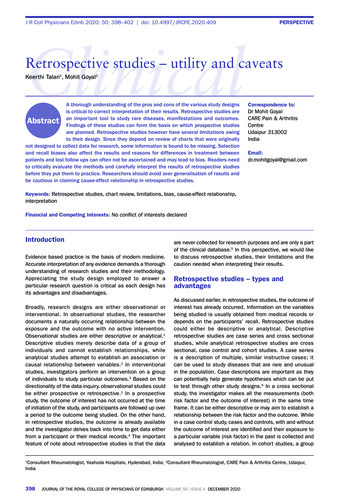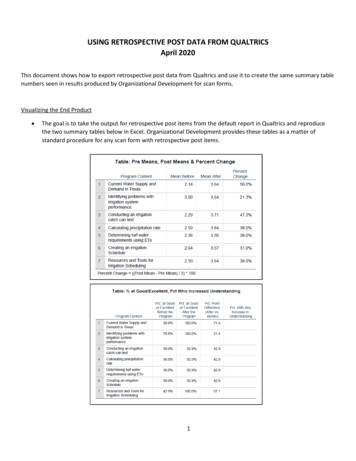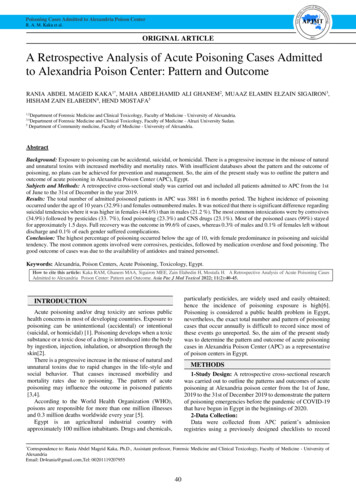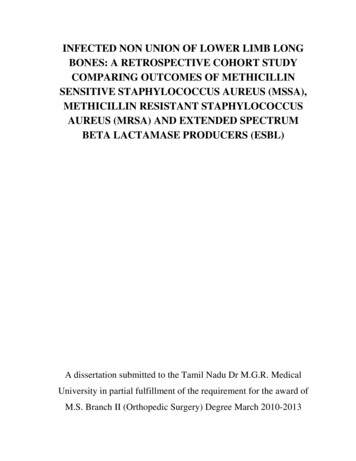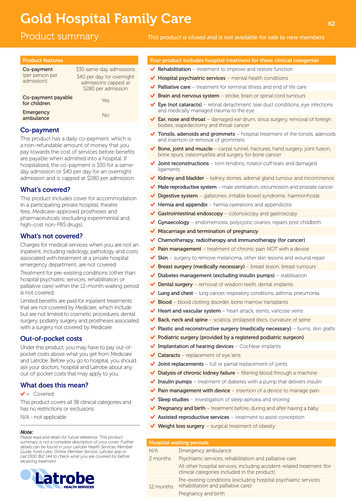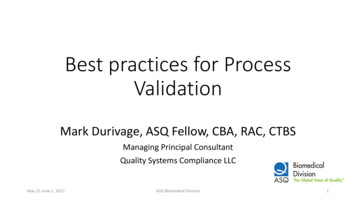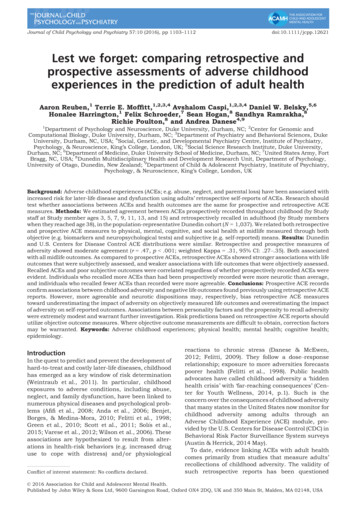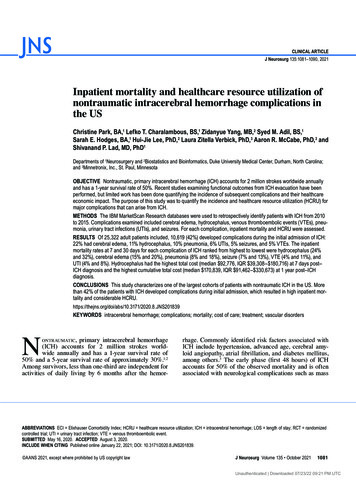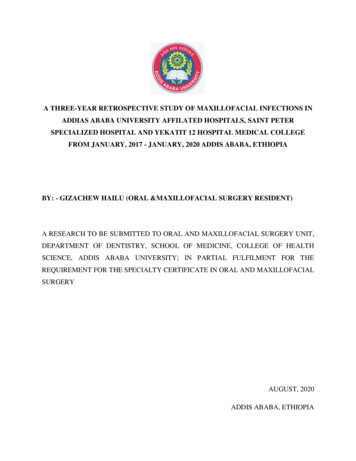
Transcription
A THREE-YEAR RETROSPECTIVE STUDY OF MAXILLOFACIAL INFECTIONS INADDIAS ABABA UNIVERSITY AFFILATED HOSPITALS, SAINT PETERSPECIALIZED HOSPITAL AND YEKATIT 12 HOSPITAL MEDICAL COLLEGEFROM JANUARY, 2017 - JANUARY, 2020 ADDIS ABABA, ETHIOPIABY: - GIZACHEW HAILU (ORAL &MAXILLOFACIAL SURGERY RESIDENT)A RESEARCH TO BE SUBMITTED TO ORAL AND MAXILLOFACIAL SURGERY UNIT,DEPARTMENT OF DENTISTRY, SCHOOL OF MEDICINE, COLLEGE OF HEALTHSCIENCE, ADDIS ABABA UNIVERSITY; IN PARTIAL FULFILMENT FOR THEREQUIREMENT FOR THE SPECIALTY CERTIFICATE IN ORAL AND MAXILLOFACIALSURGERYAUGUST, 2020ADDIS ABABA, ETHIOPIA
Addis Ababa UniversityCollege of Health ScienceSchool of medicine, Department of DentistryOral &Maxillofacial surgery UnitA three-year retrospective study of maxillofacial infections in St.Peter Specialized Hospitaland Yekatit 12 HMC from January, 2017 – January, 2020 Addis Ababa, EthiopiaBy: - Gizachew Hailu Nadew (Oral &Maxillofacial Surgery Resident)Phone 251913572592Email: gizoba@gmail.comAdvisors:Dr. Demerew Dejene Dana (DMD, Assistant Professor of Oral and Maxillofacial Surgery)Phone 251912224087Email: demewelela@gmail.comCo-Advisors:Dr. Girma Uma H/Mariam (DMD, Assistant Professor of Oral and Maxillofacial Surgery)Phone 251933542664Email:omfsgirma17@gmail.comAugust, 2020Addis Ababa, Ethiopia
AbstractBackground: Maxillofacial infections are among the most incident infections and are veryimportant due to their high rate of morbidity and probable mortality. Odontogenic originmaxillofacial infections are a common public health problem. These diseases usually originatefrom pulpal diseases, deep periodontal pockets or pericoronitis. Despite advancements inmedicine, life-threatening infections of odontogenic origin are still prevalent in many countries.Objective: To analyze the epidemiology of maxillofacial infections among patients at AAUaffiliated hospitals which is Yekatit 12 HMC and St. Peter specialized hospital, Addis Ababa,Ethiopia from January, 2017 to January, 2020.Methods: A three year retrospective study design is used among patients admitted to OMFS unitwith odontogenic and non odontogenic infections from January, 2017 to January, 2020.Themedical records of all patients who presented with maxillofacial infections during theaforementioned period were included in this study, without any kind of distinction.Results: The male to female ratio is 1.9:1and 34.3% of the patients were female the rest 67.7%were male. The mean age of the patients was 28.6 years. In 48(71.64%) cases of total 67 patientsthe infection was considered odontogenic in origin. The length of hospitalization was 6.5 days onaverage.Conclusion: Adults are majorly affected by maxillofacial infections and odontogenic origin wasmain cause.Key words: Maxillofacial infections, Odontogenic maxillofacial infection, Non Odontogenicmaxillofacial infections, Ludwig’s Angina.I
AcknowledgementI would like to express my heartfelt gratitude to Dr.Demerew Dejene and Dr. Girma Uma forbeing my advisor and their thoughtful comments. I would also like to express my gratitude toAAU, St. Peter specialized hospital and Yekatit 12 HMC for giving me this valuableopportunity.II
AcronymsAAU- Addis Ababa UniversityWHO - World Health OrganizationOMFS - Oral and maxillofacial surgeryOMI- odontogenic maxillofacial infectionsLOS- length of stayHIV- Human immunodeficiency virusDM- Diabetes mellitusMOH- Ministry of healthRHB- Regional health bureauHMC- Hospital Medical CollegeIII
Tables of contentsAbstract. IAcknowledgement . IIAcronyms . IIITables of contents . IVList of tables and figures . VICHAPTER ONE . 11.Introduction. 11.1Background Information . 11.2Statements of problem. 21.3Significance of the study . 3CHAPTER-2. 42.Literature review . 4Chapter-3 . 83.Objectives . 83.1General Objective . 83.2Specific objectives . 8Chapter-4 . 94.Methods and Participants . 94.1Study area and period . 94.2Study design . 94.3Population . 94.3.1Source population. 94.3.2Study population . 94.3.3Inclusion criteria. 94.3.4Exclusion criteria . 104.4Sample size and sampling technique . 104.4.1Sample size . 104.4.2Sampling technique . 104.5Variables . 104.6Data collection procedures . 104.6.1Disease Identification . 114.6.2Disease Classification and Categorization . 11IV
4.7Operational definitions and Terms . 114.8Data quality assurance. 114.9Data analysis . 114.10Ethical Consideration . 11Chapter-5 . 135.Results . 13Chapter- 6 . 186.Discussion and Conclusion . 18Chapter-7 . 217.References. 21V
List of tables and figuresTable 1 Mean age of patients admitted with maxillofacial infections in St.Peter SpecializedHospital and Yekatit 12 HMC from January, 2017 to January, 2020.Table 2 Frequency of maxillofacial infections based on age group among patients admitted withmaxillofacial infections in St. Peter Specialized Hospital and Yekatit 12 HMC from January,2017 to January, 2020.Table 3 Shows Length of hospital stay of patients admitted with maxillofacial infections atSt.Peter Specialized Hospital and Yekatit 12 HMC from January, 2017 to January, 2020.Figure 1 Frequency of facial spaces involved among patients admitted at St.Peter SpecializedHospital and Yekatite 12 HMC from January, 2017 to January, 2020.Figure 2 shows frequency of cause of maxillofacial infections among patients at St.PeterSpecialized Hospital and Yekatit 12 HMC from January, 2017 to January, 2020.Figure 3 Associated comorbidities with maxillofacial infections among patients at St.PeterSpecialized Hospital and Yekatit 12 HMC from January, 2017 to January, 2020.Figure 4 Management of maxillofacial infections among patients at St.Peter and Yekatit 12 HMCfrom January, 2017 to January, 2020.VI
CHAPTER ONE1.1.1IntroductionBackground InformationMaxillofacial infections of the odontogenic origin are among the most incident infections and arevery important due to their high rate of morbidity and probable mortality.(1)Odontogenicinfections are a common public health problem. These diseases usually originate from pulpaldiseases, deep periodontal pockets or pericoronitis. The primary cause of these infections is thepolymicrobial flora resident in the oral cavity entering sterile tissues resulting in inflammationand possibly abscess formation.(2)Odontogenic infections range from peripheral abscess to superficial and deep infections leadingto severe infections in head and neck region.(3)Despite advancements in medicine, life-threatening infections of odontogenic origin are stillprevalent in many countries. Treatment of these infections is challenging because potentiallyfatal complications such as sepsis, airway obstruction, cavernous sinus thrombosis, necrotizingfasciitis, and mediastinitis can occur. The standard principle for emergency treatment of theseinfections has not changed since Hippocrates, i.e., purulent infections have to be drained.(4)There are several predisposing factors which may exacerbate odontogenic infections, such asimmunodeficiency (human immunodeficiency virus HIV), long-term diabetes mellitus, obesity,and chronic alcohol abuse, hepatitis, and liver cirrhosis, immunosuppression after organtransplantation, chemotherapy, radiotherapy and systemic lupus erythematosus. Usuallyodontogenic infections respond well to a combination of surgical sanitation, incision, drainageand antibiotic therapy. Odontogenic infections exhibit a variety of different pathogens:Streptococci, especially Streptococcus viridans, a representative of gram-positive aerobicbacteria and Prevotella species, a gram-negative anaerobic bacteria are common pathogens inodontogenic infections.(5)Oral and maxillofacial surgeons usually encounter various forms of maxillofacial infections ofodontogenic origin.1
The treatment of odontogenic infections in primary stages is performed empirically. Althoughmost of them are treated as outpatients in the dental office; proper management of hospitalizedpatients still has a challenge for any clinician who works on maxillofacial infections.(1)1.2Statements of problemThe literature has well documented epidemiological studies on odontogenic infections indifferent parts of the globe. There is no report of such study from Ethiopia which is published.Therefore, the present study was designed to retrospectively evaluate all patients with orofacialinfections who were presented to our centers over 3 years period at AAU affiliated hospitals.Odontogenic infections represent one of the main reasons for consulting the emergency service.Due to the high number of cases and the severe complications, dentists have to be familiar withthe surgical management of odontogenic infections as well as the appropriate use ofantibiotics.(2)The frequency of odontogenic maxillofacial infection remained almost unchanged during a 10-yperiod. Single-space infections were more common (57.1%) than infections involving two ormore spaces. Susceptibility to penicillin remains relatively high; therefore, penicillin can remainpart of the armamentarium for treatment of odontogenic maxillofacial infections.(4)Odontogenic maxillofacial infections are a public and personal health issue with potential lifethreatening complications.(6)A 2.32:1 ratio male: female presentation mirrors previous statistics. DM patients had increasedrisks of complications, which resulted in multiple deaths. HIV patients showed increased risksfor complications with more intense, longer hospital stays, but lower percentages of deathscompared to patients with DM and complications who died.(7)The prognosis of diabetic patients is poorer than that of non-diabetic patients in secondary spaceinfections since they had greater incidence rates of involved spaces, abnormal hematologicfindings, more complications, and additional procedures, such as tracheostomy.(8)2
Antibiotic resistance is an alarming problem of significant magnitude to warrant periodicinstitution based surveillance and potentially alterations in current practice guidelines whichgenerally recommend clindamycin as first line therapy.(9)1.3 Significance of the studyOdontogenic infections are fairly common in healthcare settings. However, late presentationssuch as Ludwig's angina, facial cellulitis, necrotizing cervical fasciitis (NCF), among otherscould lead to mortality so, the purpose of this study is to assess the prevalence and describe therelationship of other important variables.Therefore, the present study will be very useful in guiding hospital managers and healthprofessionals towards odontogenic maxillofacial infections and prevalence pattern as well ashow its impact could be lowered.There are no previous study findings concerning prevalence of odontogenic maxillofacialinfections in our country Ethiopia.Finally, the outcome of this study will benefit the ministry of health (MOH), regional healthbureau (RHB), policy makers, hospital administration and practitioners in taking into account theprevalence of odontogenic maxillofacial infections.3
CHAPTER-22.Literature reviewJ. Wang, A. Ahani and M. A. Pogrel five-year retrospective study of odontogenic maxillofacialinfections in a large urban public hospital in San Francisco General Hospital shows a total of 250patients were admitted with maxillofacial infections, and in 157 cases the infection wasodontogenic in origin. Males outnumbered females (102:55). Children had a preponderance ofmaxillary buccal infections whilst adults had more mandibular infections. Hospital stays rangedfrom 1 to 23 days, and only one patient required re-admission.(6)A 6-year retrospective study evaluated hospital records of 103 patients that were treated for deepneck fascial space infections from 1997 to 2003 at The University of Medicine and Dentistry ofNew Jersey-University Hospital, Newark, NJ Patients who underwent surgical incision anddrainage in the operating room had a tendency for involvement of multiple space abscesses withthe submandibular space, submental, and lateral pharyngeal spaces effected most frequently.(10)A study in Atlanta and Boston, Mass Emory School Of Medicine And Massachusetts GeneralHospital sample consisted of 60 patients (10 HIV cases and 50 HIV– controls matched for ageand sex) with a mean age of 32.8 6.6 years and was predominately male (78%). The studyresults suggest that patients who are HIV who are admitted for management of odontogenicinfection have a significantly more intense hospital course than those who are HIV–. However,the overall length of hospital stay is not significantly different.(11)A study by Eugene W. Young and colleges in 1985 showed, Thirty-three patients admitted to thehospital for treatment of orofacial odontogenic infections, nine were treated without a dentalconsultation. There were no justifiable variations, Antibiotics were indicated and justified in100% of the cases. Eight of the thirty-three patients received antibiotics inconsistent with thesuspected organisms. Culture and sensitivity tests were found to be improper in eight of thethirty-three patients. Variations in the antibiotics prescribed could be attributed to the inadequateculture and sensitivity methods employed.(12)A broad spectrum retrospective study of odontogenic infection pattern and management at aCanadian tertiary care hospital by A. Junaid and colleges showed of the 72 patients, 37 (51%)4
were male and mean age of 36 years. The most commonly involved space was thesubmandibular in 52 patients (72%). Primary management in 100% of cases was incision anddrainage coupled with IV antibiotics. Forty-nine patients (68%) required extraction with anaverage of 2.7 teeth removed. Length of hospitalization ranged from 1 to 13 days (mean 3.6).(13)A retrospective evaluation of eight years by Bruno Veronez and colleges in Brazil; 113 patientshad odontogenic infections and 44 had non-odontogenic infections. The men were the mostaffected (53.5%). The odontogenic infections occurred mostly at the mandible (55.74%),involving the posterior teeth (82%). Dental decay was the main aetiology (90.90%). The mostaffected facial anatomic region was the submandibular (42.85%). Surgical treatment wasrequired in 76% of the cases.(14)A retrospective analysis byH. Weise, A. Naros, C. Weise, S. Reinert and S. Hoefert inGermany, sixteen patients showed odontogenic infections that spread over multiple maxillofacial and cervical regions accompanied by septic laboratory signs. All these patients neededintensive care and a tracheostomy. The hospitalization period was 27.8 days on average. In 16cases risk factors for the development of odontogenic abscesses like diabetes mellitus, obesity,chronic alcohol and nicotine abuse, rheumatism and poor oral hygiene were present.(5)A retrospective study done in Germen in 2018 showed, the length of hospital stay wassignificantly correlated with the kind of abscess diagnosed. The left primary maxillary first molarcould be identified as the most frequent source of infection. The most frequent diagnosis was acanine fossa abscess (n 52; 43.3%) and the left primary maxillary first molar could beidentified as the most frequent source of infection. The average length of hospital stay was 1.82days (ranging from 0 to 8 days).(15)Georg Cachovan and colleges in Germen of the 58 161 patients, 5357 (9.2%) were identified ashaving odontogenic infections, with 2689 (50.2%) inflammatory infiltrates and 2668 (49.8%)abscesses. Mean age was 34.8 16.8 years. As the primary site of odontogenic infection, themost significantly affected teeth were the maxillary and mandibular first molars. Patients in agegroup 20–29 years (25.1%) utilized the emergency care unit more frequently than other agegroups.(16)5
Retrospective analysis of 100 consecutive patients admitted under the care of the department ofOral & Maxillofacial Surgery at the Royal Surrey County Hospital in England of 100 patients,the male: female ratio was 54:46 with a mean age of 36 years and mean length of stay (LOS) of2.38 nights. Age, male gender and multiple space infection were associated with increasedLOS.(17)A Ten-Year Retrospective Analysis in Lithuania, Male to female ratio was 1.4:1. Two or moreanatomic spaces were involved in 42.9% of cases, 37.3% of which involved the floor of themouth. (4)Je-Shin Chang and his colleges done comparative study in diabetic and non-diabetic patients inKorea found out older age (diabetic patients: 62.9 years, non-diabetic patients, 47.8 years), morespaces involved (diabetic patients, 60%; non-diabetic patients, 27.3%), more intense treatment,longer hospitalization (diabetic patients, 28.9 days; non-diabetic patients, 15.4 days.(8)A retrospective study (2013–2015) was carried out by Sarah Wan‑Lin Lim and colleges inMalaysia in 2018, a total of 153 patients were identified, of which 83.7% were managed asoutpatients. Odontogenic infections were more common in females (52.9%) and preschoolchildren (58.2%). The most cases were seen in 2014 and maximum number of cases per monthwas 12. Common presentations were pain (62.1%), intraoral swelling (37.9%) and spontaneouspus discharge from the tooth and/or surrounding tissues (67.3%) with higher involvement ofprimary right molars. Dental panoramic tomography was the most common radiographicinvestigation done. Outpatients were commonly managed chair side with pulpal opening (46.1%)at the paediatric dental clinic and 7% underwent extraction under general anaesthesia in day-caresetting. Inpatients were admitted for 3 days on average and most commonly definitive care wasextraction under local/general anaesthesia (68%).(18)A retrospective study in Tehran in 2013 shows, the odontogenic abscesses became moreprevalent with an increase in age to 35 years, and the highest prevalence was seen in 20 to 35year-old patients. This can be due to eruption of third molar teeth, and poor oral hygiene.(1)A study in Nigeria showed Odontogenic infections constituted 11.3% of the total oral andmaxillofacial surgery cases. A total of 261 patients were treated for odontogenic infections.There were 146 female patients (59.8%) and 98 male patients (40.2%) in the first category,6
whereas the second category comprised 10 male patients (58.8%) and 7 female patients (41.2%).The fascial spaces involved, in descending order, were submasseteric in 10 (22.7%),submandibular in 9 (20.5%), and sublingual in 6 (13.6%).(19)A study in Ghana a total of 243 patients were included in the study. This consisted of 121 malesand 122 females, with an average age of 42.9 years (SD 16.6), ranging from 18 months to 91years. Incidence proportions for the years of the review were 8.2, 8.9, 17.7, 17.9 and 27.7 peopleper 1000 cases of tooth-related infections for the respective years. With a fatality rate of 5.8%,the incidence of odontogenic infections among patients attending the outpatient Dental clinic ofthe hospital is 40.3%, while that of dentoalveolar abscess is 6.2%. Ludwig's angina was thecommonest (52%) form of presentation of spreading odontogenic infection(20)A cross-sectional study Mulago Hospital, Uganda; Of the 130 patients, 62 (47.7%) were female.The most frequently involved facial spaces were: the buccal, 52 (25.4%); submasseteric, 46(22.4%) and the submandibular space, 36 (17.5%). Dental caries was the most prevalentpredisposing factor, particularly of the lower third molar teeth. Thirty five (26.9%) patients wereHIV infected and the HIV status did not significantly influence the pattern of odontogenicinfection.(21)7
Chapter-33.Objectives3.1General ObjectiveDescribe the epidemiology of oral and maxillofacial infections among patients at AAU affiliatedhospitals, Yekatit 12 HMC and St.Peter specialized hospital from January, 2017 to January, 2020Addis Ababa, Ethiopia.3.2Specific objectivesDetermine prevalence of maxillofacial infections in patients at AAU affiliated hospitals, Yekatit12 HMC and St.Peter specialized hospital from January, 2017 to January, 2020.Describe etiology of maxillofacial infections among patients at AAU affiliated hospitals, Yekatit12 HMC and St.Peter specialized hospital from January r, 2017 to January, 2020.Determine pattern of maxillofacial infections at AAU affiliated hospitals, Yekatit 12 HMC andSt.Peter specialized hospital from January, 2017 to January, 2020.Determine management of maxillofacial infections with systemic diseases at AAU affiliatedhospitals, Yekatit 12 HMC and St.Peter specialized hospital from January, 2017 to January,2020.8
Chapter-44.Methods and Participants4.1Study area and periodThe study is conducted in Addis Ababa; the capital city of Ethiopia. It is located 2500 meterabove sea level at 9.030 N and 38.70 E. it is 540,000 square kilo meter wide. Addis Ababa isdivided in ten sub cities, 116 Woreda with an area of 546 square kilometers. AAU department ofOMFS is affiliated with two hospitals which are found in Addis Ababa, these are Yekatit 12medical college which is located in Arada sub city and St. Peter Specialized hospital which islocated in Gulelle sub city. The study was conducted from April, 2020 to July, 2020.4.2Study designA three year retrospective chart review study design is used from January, 2017- January, 2020.4.3Population4.3.1 Source populationAll patients admitted to Oral and Maxillofacial surgery unit from January, 2017 to January, 2020which is total of 936 patients.4.3.2 Study populationThe medical records of all patients who were diagnosed with maxillofacial infections during theaforementioned period were included in this study, without any kind of distinction which is totalof 85 patients.4.3.3 Inclusion criteriaAll maxillofacial infection diagnosed and admitted patients with complete chart from January,2017 to January, 2020.9
4.3.4 Exclusion criteriaThe exclusion criterion is incorrect or incomplete patient records such as missing age, gender,diagnosis etc. Total of 18 medical cards were excluded.4.4Sample size and sampling technique4.4.1 Sample sizeA total of 67 patients were included in the study period.4.4.2 Sampling techniqueConvenient sampling technique was used4.5VariablesIndependent VariablesAgeGenderEtiologyPast medical historyTreatment regimenLength of hospital stayDependent VariableMaxillofacial infection4.6Data collection proceduresData collection was undertaken in July, 2020 in Yekatite 12 medical college and St. PeterSpecialized hospital. Data was collected through medical record reviews of patients using aprepared data extraction format to collect information on, socio-demographic, patient details,investigations, comorbidities, diagnosis.10
4.6.1 Disease IdentificationIdentification of disease done by using clinical diagnosis feature documented in patient chart.4.6.2 Disease Classification and Categorization4.7Operational definitions and TermsMaxillofacial infections: - infection of maxillofacial region due to odontogenic and nonodontogenic diseases origins.Odontogenic maxillofacial infections: - infection of maxillofacial region due to dental diseaseslike tooth decay and periodontal diseases.Ludwig’s Angina: - infection of maxillofacial region involving bilateral submandibular,sublingual and submental spaces.Comorbidities:-any significant disease which coexists with odontogenic maxillofacial infections4.8Data quality assuranceThe data collectors were oriented on how to collect the data of study requirements includingobjectives of the study, definitions and the documentation processes, prior to data collection. Thedata collection process involves rigorous patient chart review. The patient card number is used,to check validity and completeness of the information. The data collector strictly superviseddaily and the principal investigator reviews all filled format so that any suggestion andcorrections were given soon.4.9Data analysisCompleteness of the data checked every day and was entered and cleaned using Epi-data version7 was used for analysis by the principal investigator. Descriptive analysis was computed asfrequency, percentages, cross tabulation, of different variables were determined. Finally the outputs of processed presented using tables, graphs, & figures accordingly.4.10 Ethical ConsiderationEthical approval obtained from the department of Research and Ethics Review Committee(DRERC) of Addis Ababa University College of Health Sciences, department of dentistry ofAAU to conduct this study and St. Peter Specialized Hospital Ethical Review Committee Office11
(ERCO) and Addis Ababa Health Bureau IRB(Internal Review Bored) . A letter informing toYekatit 12 Hospital Medical College and St.Peter specialized Hospital was written from Ethicalcommittee of Departmental Research and Ethics Review Committee (DRERC) about the study.All eligible charts were retrieved. All the information obtained from the study subjects werecoded to maintain confidentiality.12
Chapter-55.ResultsOver the study period, 67patien
Oral &Maxillofacial surgery Unit A three-year retrospective study of maxillofacial infections in St.Peter Specialized Hospital and Yekatit 12 HMC from January, 2017 - January, 2020 Addis Ababa, Ethiopia By: - Gizachew Hailu Nadew (Oral &Maxillofacial Surgery Resident) Phone 251913572592 Email: gizoba@gmail.com Advisors:-
